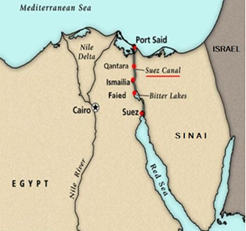TAG: GS-1: HISTORY & GEOGRAPHY
CONTEXT: The Suez Canal, a vital maritime waterway linking the Mediterranean to the Red Sea, has been a cornerstone of global trade for over 155 years. It is one of the world’s busiest waterways, handling about 12% of global commerce.
EXPLANATION:
What was the historical background of the Suez Canal?
-
- The canal was built by French engineer Ferdinand de Lesseps and opened in November 1869. The canal connects the Mediterranean Sea directly to the Red Sea.
- The 155-year-old canal was controlled by British and French interests in the early years. Still, the Suez Crisis, an international crisis in the Middle East, began in July 1956 when Egyptian President Gamal Abdel Nasser nationalized the Suez Canal. The Suez Canal Company owned the canal, which French and British interests controlled.
- Today, the Suez Canal Authority (SCA), an Egyptian entity, manages and operates the canal.
- In 2015, Egypt inaugurated a significant expansion project, including a parallel waterway to reduce transit times and accommodate larger ships.
About Suez Canal:
-
- The Suez Canal is anartificial sea-level waterway running north to south across the Isthmus of Suez in Egypt, to connect the Mediterranean Sea and the Red Sea.
- It spans northeastern Egypt, linking Port Said on the Mediterranean coast to Suez on the Red Sea coast.
- The canal separates the African continent from Asia.
- The canal separates the African continent from Asia. It is one of the world’s most heavily used shipping lanes, carrying more than 12% of world trade by volume.
- An average of 51.5 ships per day will pass through the canal, which stretches about 120 miles (193 km) from the city of Port Said in the north to the city of Suez in the south, according to data from the Suez Canal Authority (SCA).
- The canal is a primary source of income for Egypt’s economy, with the African country earning US$5.61 billion in revenue last year.
- It is a vital international shipping route, allowing ships to navigate between Europe and Asia without circling the African continent.

Significance of Suez Canal:
-
- Global trade– The canal is a vital link between the West and East, carrying 10% of the global trade every year.
- An estimated 12% of world maritime trade passes through the Suez Canal.
- Time efficient– The canal ensured that ships travelling between Europe and Asia would not have to travel all the way around the continent of Africa.
- The canal cut the distance between London and Mumbai by a more than 41%.
- Economy lifeline– As per World Bank, the canal accounts for nearly 2% of Egypt’s GDP.
- Traffic management– The canal handles an average of 50 ships per day, with a total value of 9.5 billion dollars.
- Global trade– The canal is a vital link between the West and East, carrying 10% of the global trade every year.
Importance of Suez Canal for India:
-
- The canal carries 12% of world trade, 7% of world oil and 30% of container ships daily. Since the canal has no locks, it can also handle aircraft carriers.
- The canal provides a direct route between Europe and Asia. This saves fuel and reduces transportation costs, making international trade cheaper.
- The location of the canal makes it a vital link for shipping crude oil and other hydrocarbons from countries like Saudi Arabia to Europe and North America.
- The canal carries 12% of world trade, 7% of world oil and 30% of container ships daily. Since the canal has no locks, it can also handle aircraft carriers.
- The canal provides a direct route between Europe and Asia. This saves fuel and reduces transportation costs, making international trade cheaper.
- The location of the canal makes it a vital link for shipping crude oil and other hydrocarbons from countries like Saudi Arabia to Europe and North America.
- Indian trade worth $200 billion to/from North America, South America and Europe is carried out using this route.
- India is a significant route for importing and exporting ethane with the US and importing crude oil from Latin America. Hence, it is essential for India’s energy security.
- It enables the Indian Navy to have a strong regional presence and participate in global naval operations. This highlights its strategic importance to India.
Source:
Spread the Word
